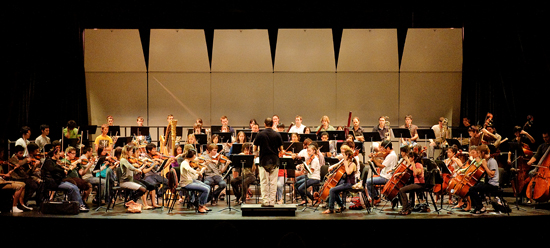When the UCLA Philharmonia was first founded in 1936, one of its main goals was to perform the best in both contemporary and rarely performed works. On Oct. 29, one of UCLA Philharmonia’s first performances of the year plans to do just that with a playlist that combines the ever-popular Mozart with the slightly lesser known Mahler.
Led by musical director and conductor Neal Stulberg, UCLA Philharmonia is composed of 75 undergraduate and graduate students studying music. For their first performance, they will be performing Mozart’s Piano Concerto No. 20 in D minor and Gustav Mahler’s Symphony No. 5.
“Together these two pieces make up a real journey for the listener,” Stulberg said. “The Mozart concerto, unlike most of his other piano concertos, is a very dark, turbulent work, which has always been regarded as a visionary pronto romantic piece.”
Henry Shin, a graduate student studying orchestral conducting who works with Stulberg and the UCLA Philharmonia, said he enjoys this piece because it’s another side of Mozart that people are not usually allowed to see.
“A lot of pieces by Mozart are in the major key, which for the nonmusician would be happy sounding; this piece is in D minor, which would be a “˜sad key.’ Minors have a very special quality. They tend to be more intimate and very personal, and the audience can clearly hear this from the get go,” Shin said.
The intimacy of this piece is shown not only in the music itself but also through the way it is performed. Instead of simply conducting the orchestra, as he normally would, Stulberg will be playing a solo on the piano, making this performance more like chamber music.
Jorge Uzcategui, another graduate student studying orchestral conducting and who works with Stulberg and the UCLA Philharmonia, claims that while this piece is a different side to Mozart, it is one of his more popular works.
“Out of his 27 concertos, Mozart only wrote two minor key concertos, this one and No. 24 in C minor, so this concerto is really special. It is considered to be one of Beethoven’s favorite Mozart concertos, and you can really see the influence in Beethoven’s work,” Uzcategui said.
“(Mahler’s Symphony No. 5 is) one of the most explosive, titanic pieces of music ever written for orchestra,” Stulberg said.
Even though the piece is lengthy, it keeps its audience interested by exploring different musical styles.
“Mahler’s Symphony No. 5 is a gigantic 65-minute piece that explores every human emotion from death to grotesque dances to the exhilaration of a first love to a gorgeous song of affection, to a blazing glory of a conclusion,” Stulberg said.
Mahler wrote nine symphonies in his life and many other long works and song cycles. He wrote this particular piece sometime between 1902 and 1911.
“His music, in the time it was written, affected audiences in the deepest kind of way, and still speaks deeply to all sorts of listeners. His songs possessed huge power with enormous sound but could also be incredibly tender and personal,” Stulberg said.
This is the first time that UCLA Philharmonia will attempt a Mahler piece since Stulberg has been at UCLA.
“Playing a symphony by Mahler is a pinnacle of achievement for any musician, whether they are a student or a professional. It is a huge mountain to climb and is unbelievably tiring and hard,” Stulberg said.
To achieve this feat, members of UCLA Philharmonia must be dedicated to master this piece.
“Since UCLA Philharmonia is a university orchestra, we don’t get to rehearse every day,” Uzcategui said. This lack of scheduled practice time demands a personal dedication to the music from each and every student.
“Students need to practice on their own. Every member should feel as if they are playing a solo performance. They need that technical proficiency, because if one member lacks it, it will show in the group,” Uzcategui said.
The musicians also need to build up their endurance to perform such a long piece.
“The piece is so long and profound, it is easy to lose the energy at some point,” Uzcategui said. “In order to keep the music alive, the orchestra practices applying focus to specific parts of the performance.”
Shin said that focusing on certain parts of the piece benefits not only the orchestra but the audience as well.
“It requires a lot of patience to sit through a symphony this long. To keep the audience interested we focus on lush melodies and really intense and sensitive moments. That way the music is easier to grasp, like playing short YouTube clips as opposed to a long video,” Shin said.
This feat is made even harder by the fact that this performance is only the second of the year.
“We have a lot of incoming freshmen, graduate students and transfer students. Playing a Mahler piece can be quite daunting for the freshmen because most have never played a piece like this before. It’s like comparing Algebra 1 to multivariable calculus,” Shin said.
So why is Stulberg starting off the year with such a difficult piece?
“These pieces are something very extraordinary. To see your classmates take on this work, it’s something both the performers and the audience can be proud of. As for the difficulty, if the level of skill were not there, these pieces would not have been chosen,” he said.
With such an ambitious set list, the performance promises to be the start of an exciting year.
